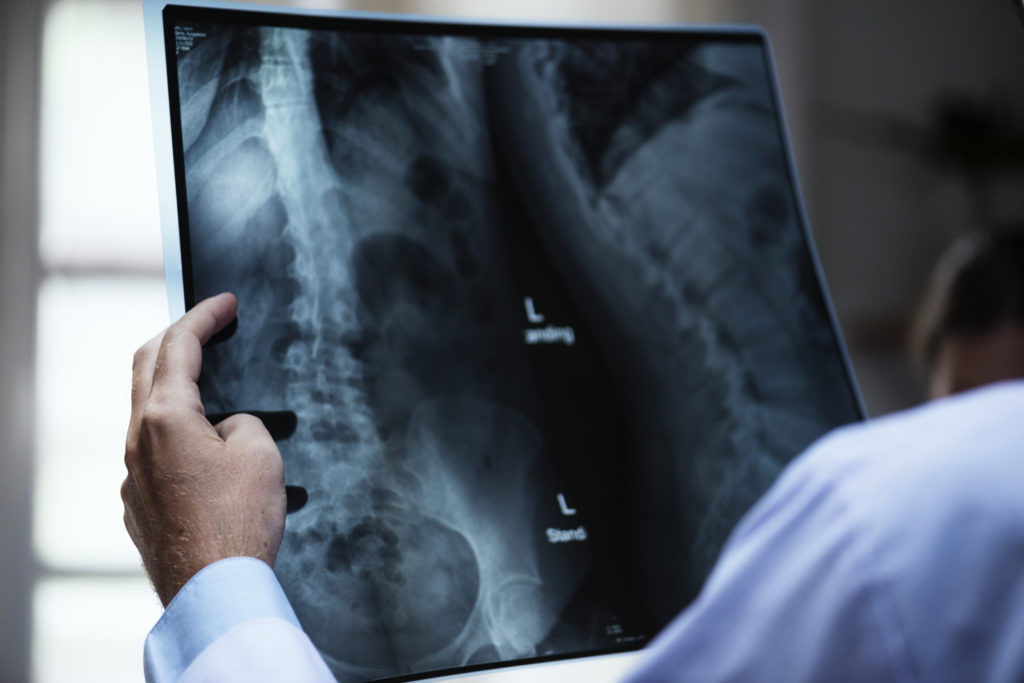
This blog is part of the Analyzing Scoliosis series, which is designed to teach movement practitioners how to work confidently with clients who have scoliosis. Previous posts have discussed the typical scoli body, common types of scoli (AIS and functional scoliosis), and how to decide when to work with a client. My book, Analyzing Scoliosis, which covers the topics in this series (as well as others) in more depth, is available on Amazon.
All too often “scoliosis” is thrown around any time a spinal issue is at play, whether a true case of scoliosis is present or not. I’ve encountered so many people who think they have scoliosis, and may have even received a diagnosis from a doctor; however, upon further inspection of their spine, it’s not scoliosis at all. Sometimes it’s a completely unrelated issue. As a movement practitioner, it’s important for you to be able to discern between what is and isn’t scoliosis so you can create a customized exercise plan based on your client’s actual body, not their assumptions or guesses. Please remember though that as Pilates instructors we can’t diagnose clients.
So, to help you determine what is or isn’t scoliosis, let’s start by reviewing its core definition. Scoli is a lateral curve of the spine of 10 degrees or more. That’s it. It really is that simple. If a spine does not adhere to that simple definition, it’s not scoliosis. It’s something else. Period.
Let me share two examples of issues that could look like scoli (especially to an uninformed person), but are in fact not scoliosis: disc injuries and bad posture. I’ve had several clients come to me with these issues (among many others) that thought or were told they had scoliosis. I knew they didn’t. How? I checked their spine (more on how to do this in future posts), and it was straight. No lateral bending was present, so despite not being able to make a diagnosis, I knew it wasn’t scoli.
Why do these misdiagnoses, both by patients and medical professionals, occur?
Most people coming to you will simply have little to no knowledge about their own condition. When a new scoli client walks through your door on that random Tuesday in three years, it’s very likely that they’ll be caught in a web of unclear information—or flat out incorrect facts—that they’ve found on the internet or that someone has given them about their condition.
Unfortunately, many of the medical professionals your clients will have seen may not know as much about scoliosis as you’d hope. A study shows some horrible statistics about physiotherapy students trained in the UK [1]:
- only 52% of students recognized that the cause of idiopathic scoliosis is unknown
- 88% incorrectly defined scoliosis as a two-dimensional deformity
- only 12% knew the criteria for diagnosis
- an astounding 93% were unable to recognize the correct treatment approach through therapeutic exercise
This study may have been in the UK, but the lack of knowledge surrounding scoliosis isn’t limited by geographical location. A previous study in the United States didn’t look much better [2]. Yikes! Medical practitioners like those in this study are out there in the world “guiding” your clients through their scoliosis journey—it’s practically the blind leading the blind. I’m not saying that all medical professionals are this poorly informed about scoliosis, but it’s certainly alarming to think about the ones who are this clueless about scoli.
Truthfully, I believe all this misinformation and lack of knowledge is one of the main reasons people with spiral spines are so emotional over their diagnosis. They don’t know the hard, black and white facts about scoliosis. All they know is that they’re in pain and they have something “abnormal” about their spine that requires attention. Sometimes, they’re even receiving conflicting advice from the multitude of medical professionals they’re consulting about their condition. Combine all of that, and it’s a recipe for emotional exasperation.
As a Pilates instructor, how do you handle this situation?
Take any diagnosis with a grain of salt (and analyze for yourself!).
Even when a scoliosis diagnosis is given by a medical practitioner, it isn’t always correct. Carefully weigh all the suggestions that your scoli client (or “assumed scoli” client) received prior to seeing you.
Do those suggestions line up with what you know to be true about scoliosis? Do you personally see signs of scoliosis in your client? Trust your training and your eye for alignment, and reassess your client’s body for yourself, regardless of their diagnosis or their assumptions about their spine and body. Decide for yourself what the most pressing issues are in your client’s body, and let those issues—not their “on paper” diagnosis—guide your focus during lessons. You just might find your client’s issues or pain don’t stem from scoliosis at all.
I want to add one last note about the myths and incorrect “facts” about scoliosis. I’ve heard too many Pilates instructors (and people in general) say something like, “everyone has a little bit of scoliosis.” Hear me when I say: this is simply not true. Many people have muscular discrepancies on either side of their spine, but that is not the same as having scoliosis. You can have uneven muscle development and still have a straight spine. Please don’t repeat this incorrect myth. Please don’t disregard the condition that is scoliosis by nonchalantly saying, “everyone has it.”
Let’s repeat it one more time so we never forget: scoliosis is a lateral bend of the spine that measures 10 degrees or more. If that definition doesn’t apply to a spine’s behavior, then you’re not dealing with scoliosis.
Sources List
1 Black, D.A. Jason, Picher, Christine, Drake, Shawn, et al. “Current knowledge of scoliosis in physiotherapy students trained in the United Kingdom.” Scoliosis, vol. 12, no. 34, 2017.
2 Drake, Shawn, Glidewell, Michael, and Thomas, Jerrica. “Current knowledge of scoliosis in physical therapy students trained in the United States.” Scoliosis, vol. 9, no. 1, 2014.


Leave a Reply